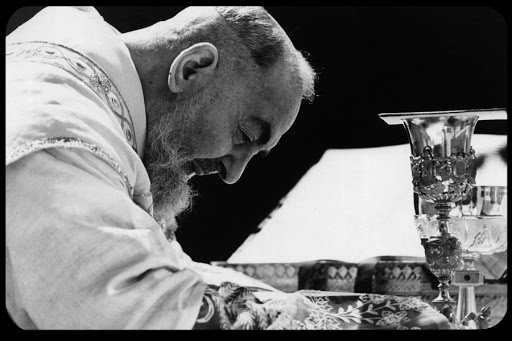The Italian mystic appeared by the grace of God to converse with Cardinal Mindszenty after the Hungarian bishop was condemned to life in prison.
The holiness of the Capuchin priest Francesco Forgione, born in Pietrelcina, Italy in the year 1885, was a devout certainty for many of the faithful, even before the “gifts” that history and witnesses attribute to him—stigmata, bilocation (being in two places at once), the ability to read consciences while hearing confessions, and to intercede in prayer for God to heal people—were common knowledge. Saint John Paul II officially canonized him on June 16, 2002, as Saint Pio of Pietrelcina, whose feast is celebrated by the Church on September 23.
Francesco was ordained to the priesthood on August 10, 1910, in the Cathedral of Beneveto, and on July 28, 1916 he moved to Saint Giovanni Rotondo, where he remained until his death on September 23, 1968. That is where the apostolate of Francesco (Padre Pio) begins, and touched the heart of the poor and the sick in body or in spirit, those whom he loved most. To save souls was his guiding principle. Perhaps that’s also why the devil attacked him constantly, and God allowed those attacks in harmony with the salvific mystery that he wished to express through Padre Pio.
Hundreds of books, movies and websites recount his life story and the action of God’s grace that reaches many people through his mediation. This is why many of his devotees will rejoice in the revelations contained in the book “Padre Pio: la sua chiesa, I suoi luoghi, tra devozione, storia e opera d’arte” (“Padre Pio, His Church and His Places: Devotion, History, and Works of Art”), according to a recent article by the renowned Vaticanist, Andrea Tornielli.
The witness who interviewed Padre Pio himself
Andrea Tornielli relates that the book contains the story of Angelo Battisti, director of the Casa Alivio del Sufrimiento (House for the Relief of Suffering), and typist for the Vatican Secretariat of State. Battisti was one of the witnesses in the process of beatification of the holy friar.
Cardinal József Mindszenty, archbishop of Esztergom, Prince Primate of Hungary, was imprisoned by the Communist authorities in December of 1948 and condemned to life in prison the following year.
He was falsely accused of conspiring against the Socialist government. He was in prison for eight years, then under house arrest, until being freed during the popular uprising of 1956. He took refuge in the United States’ Embassy in Budapest until 1973, the year in which Paul VI forced him to leave and to renounce his archdiocese.
During those years of prison, Padre Pio appeared in Cardinal Mindszenty’s prison cell by bilocation.
In the book, Battisti describes the miraculous scene as follows:
“While he was at Saint Giovanni Rotondo, the Capuchin who bore the stigmata went to bring the Cardinal bread and wine destined to be transformed into the body and blood of Christ…”
“The register number printed on the prisoner’s uniform is symbolic: 1956, the year the Cardinal was freed.”
“As is known,” Battisti explains, “Cardinal Mindszenty was taken prisoner, thrown in prison and kept in sight by the guards at all times. As time passed, his desire to be able to celebrate Mass became very intense.”
“A priest who came from Budapest spoke to me confidentially about the event, asking if I could obtain confirmation from Padre Pio. I told him that if I had asked about something like that, Padre Pio would have scolded me right out the door.”
But one night during March of 1965, at the end of a conversation, Battisti asked the stigmatized Capuchin:
“Father, did Cardinal Mindszenty recognize you?”
After a first irritated reaction, the saint answered,
“We met and we had a conversation, and you think he might not have recognized me?”
This confirmed his bilocation to the prison, which had taken place several years earlier.
“Then,” Battisti added, “Padre Pio became sad and added, ‘The devil is ugly, but they had left him uglier than the devil,’” referring to the maltreatment that the Cardinal suffered.
This shows that Padre Pio had brought him help from the beginning of his time in prison, because humanly speaking one cannot conceive of how the Cardinal was able to resist all the suffering to which he was subject, and which he describes in his memoires.
Padre Pio then concluded, “Remember to pray for that great Confessor of the Faith, who suffered so much for the Church.”
Republished with permission from Portaluz.

